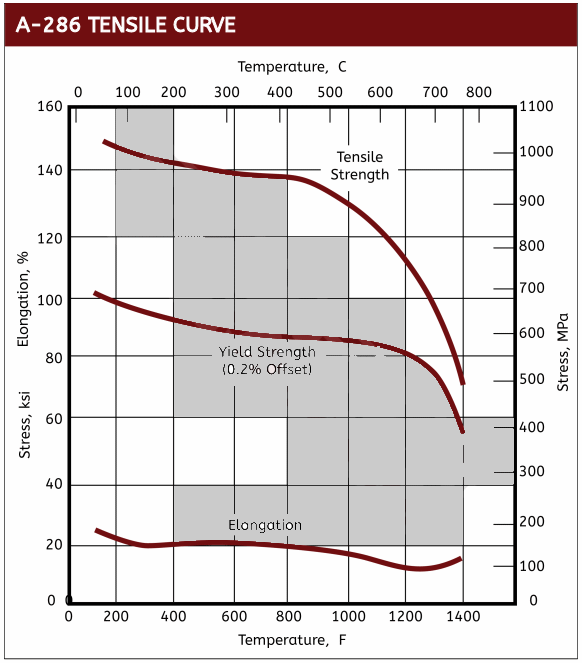A286 / Alloy 660 for excellent high temperature oxidation resistance
- Good material for high temperature oxidation resistance

- Maintains high strength at elevated temperatures
- Material specs & heat treatments
- A286 chemistry
- ASTM A453 Grade 660
- A286 Datasheet
A286 screws, also known as Alloy 660 screws are stainless steel alloy which contains iron, nickel and chromium. A286 flat head screws are known for their high strength, creep resistance and oxidation resistance at elevated temperatures once age hardened. As a result, A286 screws provide high levels of strength from room temperature up to about 1300°F (700°C).
A286 flat head screws are also mildly corrosion resistant. While they should not be used for strong acid environments, they provide excellent oxidation resistance up to 1500°F (815°C) in conditions that would typically be found in high temperature exhaust streams.

Applications
Because of the properties of Alloy 660 / A286, these flat head screws are often found in high temperature engine, manifold, exhaust and turbine applications as well as off-shore oil & gas applications. In addition, A286 / Alloy 660 is also non-magnetic and finds a niche in non-magnetic cryogenic equipment. For the most critical applications, we also offer fastners per ASTM A453 Grade 660 specification. This ensures specific tensile strength and rupture properties.
Resources: A286 Torque Specs
Screw Types: 12 Point Screws, Button Head Cap Screws, Flat Head Screws, Hex Cap Screws, Pan Head Screws, Set Screws, Socket Head Cap Screws, Tamper Resistant Security Screws, Torx Screws, Vented Screws
A286 / Alloy 660 Flat Head Screw Features and Benefits
A286 / Alloy 660 flat head screws are characterized by having a head with a top flat surface (which can feature either a slotted, phillips or allen driver) and bottom that is cone shaped or countersunk. With this design, the head of the screw can align flush or below the surrounding surface having obvious benefits.
A286 Slotted vs. Phillips Driver
| Slotted Head Advantages | Phillips Head Advantages |
|
|
Countersink Angle
For most flat head screw designs the angle of countersink is usually 82° for UNC and UNF applications however other angles ranging from 60° -120° could be specified.
| Thread Type | Normal Flat Head Countersink Angle |
UNC / UNF | 82° |
| Aerospace | 100° |
| ISO Metric / Imperial | 90° |
ASTM A453 Grade 660
Material specification ASTM A453 Grade 660 applies to bolts, studs, studs and other fasteners. It ensures fasteners meet strength standards for use in high temperature bolting applications. ASTM A453 Grade 660 is classified into 4 property classes / heat treatments: A, B, C & D, each designated with different tensile and stress rupture properties. The most common of the ASTM 453 classes are class A or D. The grades A, B and C all have the same minimum tensile strength and minimum yield strength of 130ksi and 85ksi respectively. However grade D has a significantly better yield with a min tensile of 130ksi and a min yield of 105ksi.
Additional A286 / Alloy 660 Specifications, Cold Working & Heat Treatments
AMS A286 / Alloy 660 Heat Treatments
By AMS numbers, the most common for A286 / Alloy 660 is AMS 5737 (same as Grade A) and then AMS 5732 (same as Grade B).
A286 / Alloy 660 Cold Worked Fasteners
For additional strength, A286 could be aged and cold worked to achieve a min ultimate tensile strength of 160ksi upon request.
Additional Specifications
UNS S66286, ASTM A453, AMS 5525, AMS 5726, AMS 5732, AMS 5737, AMS 5804, EN 1.4980, GE B50T1181, GE B50T12, GE B50T81, Werkstoff 1.4980
A286 / Alloy 660 Chemistry
Mechanical Properties



